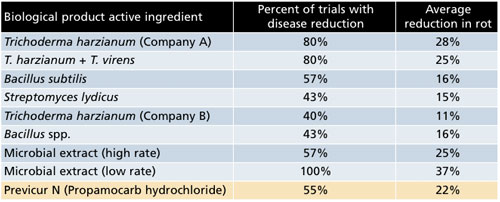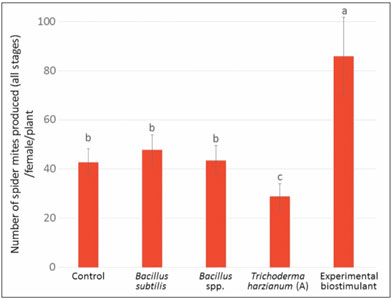8/31/2017
Not Just for Bugs
Ashley Summerfield, Anissa Poleatewich, Rose Buitenhuis and Michael Brownbridge
The use of biological control has been steadily increasing in both ornamental and vegetable greenhouse crops, especially when it comes to managing pests. In a 2014 survey, 69% of ornamental growers and 95% of vegetable growers in Canada were using biocontrols to manage pests, but only half of those (45% and 48%, respectively) were using biocontrol to manage disease. When people think about biological control they typically think about predators and parasitoids—but it’s more than just bugs! Biocontrol includes the use of any living organism, which also includes biopesticides and biological materials, such as beneficial fungi and bacteria, and microbial extracts.
Disease outbreaks can be hard to detect early, are difficult to recover from and can cause devastating losses. When growers start using biological control for pests, they need to change the way they view pest management and move from taking a reactionary approach to a preventative approach in order to be successful.
Since many disease-management programs rely on the use of preventative measures as a first line of defense, the use of microbial biocontrol agents within these programs should be a natural fit. Why aren’t more growers using them? To start, the recent explosion of new biopesticides on the market has made choosing them complicated, especially since each product is touted to be better than their competitors for controlling disease. More importantly, will they work as well as the chemical fungicide that you’ve been relying on for years? It’s no wonder that growers have been a little hesitant to make the switch.
Putting biological products to the test
At Vineland Research and Innovation Centre, we’ve been trying to answer those questions. We used commercial, hydroponically grown tomatoes as our model system to determine just how good these biological products are at preventing a common root disease, Pythium Root and crown rot. We tested the efficacy of nine different biological products against that of the industry standard fungicide, Previcur N (Propamocarb hydrochloride), to see how each measured up.
The biological products we tested consisted of five different registered biopesticides, two different microbial extract products and one microbial inoculant product. We applied the first treatment of the different products at transplant to the block and again at transplant to the slab. We then infested each plant with Pythium and assessed disease severity after two to three weeks. Results of 11 different trials are summarized in Table 1.
Table 1. Biological product efficacy against Pythium root rot; summary of results from all experiments.

Most of the biological products we tested performed as well as, if not better than, the standard chemical fungicide. The top-performing products reduced root disease by 25% to 37%, whereas Previcur reduced root disease by 22% on average. We found a wide range of efficacy and consistency among products, even among products whose active ingredients are in the same genus, e.g., Bacillus or Trichoderma, demonstrating that product formulation and production practices are just as important as the species and strain of the organism being used.
In some experiments, we also observed a trend that suggested that a higher concentration of product doesn’t always translate to greater efficacy. With the microbial extracts, for example, the lower rate actually gave better results. However, additional replication is needed to validate this observation. Efficacy also varied according to slab type (rockwool vs. coco fiber), crop (tomato vs. cucumber) and crop variety.
These experiments were conducted year-round over the course of two years, within which we started to notice that some products performed better in the spring/summer and others performed better in the winter months. Irrigation water temperature, daylength and ambient temperature may have all contributed to these seasonal effects. Slab temperatures above or below the ideal range for registered and candidate biocontrol microbes may limit their activity. Further research is needed to determine the exact cause of these seasonal effects and how best to use them to our advantage, e.g., through better product selection to match the prevailing growing conditions throughout the crop cycle.
Systemic resistance and what it means for pests
Biopesticides work to protect roots against disease in a number of ways: they can competitively exclude pathogens, they can directly fight pathogens through excretion of antimicrobial compounds, they can parasitize pathogens or they can activate the plant’s own defense mechanisms. We call this last process “induced systemic resistance.” So if we’re inducing resistance in the roots, what does that mean for the rest of the plant?
 Figure 1. Effect of biological products on plant resistance to two-spotted spider mites in tomato (cv Endeavour).
Figure 1. Effect of biological products on plant resistance to two-spotted spider mites in tomato (cv Endeavour).
On the positive side, this could mean we’re making the whole plant stronger and more resistant to diseases and pests. However, a plant’s “immune” system has competing resistance pathways that do different jobs. So typically, when the resistance pathway that combats disease is activated, it may come at the expense of the pathway that combats certain pests. Hence, potentially inducing resistance to root diseases might leave the foliage more susceptible to herbivore attack, which would be an unwelcome side effect.
To figure this out, we tested commonly used biopesticides, a microbial inoculant, and an experimental biostimulant to determine what effect they would have on the plants’ natural resistance to two-spotted spider mite and greenhouse whitefly. Again, this was done in a hydroponic system using commercial substrates and varieties. We treated the plants as we did in the disease trials, however, instead of infesting with a pathogen, we infested the plants with spider mites or whiteflies one week after the plants were transplanted onto the slab. We allowed the pests to complete one generation on the plant, and then we assessed the size and development time of the pest populations.
We found that the plant response to the biological products differed according to the tomato variety tested. Komeett is naturally more resistant to both whiteflies and spider mites; however, this variety didn’t respond to the biological products we tested in terms of our seeing differences in pest population development on treated vs. non-treated plants.
Endeavour, on the other hand, was more susceptible to both pests and application of Trichoderma harzianum (Company A) resulted in lower spider mite populations on treated plants, while the application of an experimental biostimulant appeared to make Endeavour more susceptible to spider mites. We found no evidence that Bacillus-based products had an effect on pest resistance in either of the tomato varieties tested.
Streptomyces lydicus yielded contrasting data. In one experiment spider mite populations were lower on treated Endeavour plants, whereas in the next experiment spider mites increased, suggesting there are likely other factors involved, such as seasonal effects on plant responses to these materials, as seen in the disease trials.
Take-home messages
The disease trials demonstrated that the biological products tested performed just as well, if not better, than conventional chemical fungicides. Biological products can be used on their own, or may be best used in rotation or as tank-mix partners with traditional fungicides. However, more work is needed to understand how to combine these products to achieve the optimum results.
Endeavour was more resistant to spider mites when treated with Trichoderma harzianum (Company A), however, no effect was observed on Komeett. The fact that product effects were so different in different varieties highlights the importance of always testing new pest and disease management methods on a small subset of your crop, to see how the crop responds to the treatment applied.
We saw that some products had no effect on pest development, but may impart other beneficial effects such as improved nutrient uptake or greater tolerance against other stresses. Most researchers are typically only able to trial products on a few varieties and those included might not react the same as the varieties you’re growing. Although our research was done on tomatoes, the majority of the products we tested are registered or available for other vegetable crops, as well as ornamentals, and a range of effects are likely to be observed in these crops, too.
From the outset, it was our goal to work with industry partners to bring commercial relevance to the results, be it in the tomato varieties used (commercially grown), production practices and substrates, and products tested (available or close to market). Results from the trials hopefully provide valuable new insights for growers, and may be used to improve the products included or at least to provide guidance for each company’s own R&D efforts.
The news for biopesticides and other beneficial biological products is overwhelmingly positive: with biological products that perform as well as chemical fungicides, and are unlikely to disrupt your pest management system (and may even help!), biopesticides are a tool that you should add to your IPM toolbox today.
GT
Acknowledgments: This project was funded in part through Growing Forward 2 (GF2), a federal-provincial-territorial initiative. The Agricultural Adaptation Council assists in the delivery of GF2 in Ontario. Further funding was provided by the Ontario Greenhouse Vegetable Growers, Koppert Canada, TerraBioGen, BioWorks, Crop Defenders, Novozymes Biologicals and ProPlant Propagation.
Ashley Summerfield is a Research Technician—Biological Control; Dr. Rose Buitenhuis is a Research Scientist—Biological Control; and Dr. Michael Brownbridge is Research Director, Horticultural Production Systems for the Vineland Research and Innovation Centre. Dr. Anissa Poleatewich is Assistant Professor of Plant Pathology and Host-Microbe Interactions, Department of Biological Sciences at the University of New Hampshire.